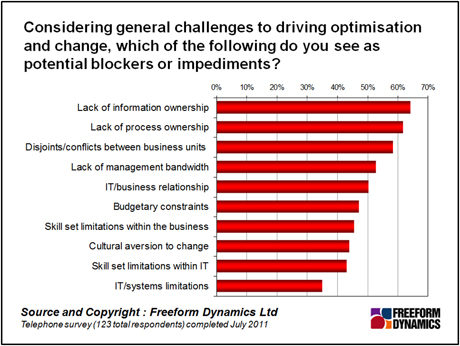A lot of time and column inches have been spent over the years looking at the state of corporate IT systems and their inability to accommodate new ideas or support changing needs within the business. At a time of great competition and economic stress, this rhetoric around the supposedly poor state of IT seems to have become more common. The “IT is broken” or “IT is failing” lines make for provocative media stories. They also provide a good lead in to supplier pitches around “transformational” magic bullets to fix things.
But is everything really that bad in the domain of IT?
Recent research carried out by Freeform Dynamics raises some interesting questions concerning how much of a hindrance IT is to organisations as they seek to change and evolve. In a survey conducted earlier this year, senior line of business managers and executives were asked to indicate the biggest impediments to change in their environment. They responded by identifying matters that can be grouped into three main classes, namely internal business process challenges and intra-business relationships, budgetary constraints and culture, and finally IT systems and business / IT relationships.

Despite the huge volumes of marketing and media coverage based on the negative rhetoric, the results indicate that IT is often the least of people’s problems. Sure, a third of respondents perceive IT systems limitations to be a challenge, but it’s at the bottom of the list, which otherwise consists almost entirely of problems associated with people and processes within the business.
With this in mind, it’s important to keep a sense of perspective and not get swayed by the propaganda from IT vendors keen to promote their latest answer to solve all known problems in the business universe. Some obvious recent examples of excessive over-positioning include SOA and Cloud, with the mantle now being picked up by Big Data. The truth is that IT limitations are often a relatively small part of the problem, so fixing them can only get you so far.
This is not to say that IT systems and processes could not be improved in many, if not all, organisations. IT, as every other area of business, needs to change as new ideas emerge and business operations continue to evolve and transform.
Against the broader background we have been discussing, rather than dwelling on what might be broken with IT a more useful question to ask is “what can IT potentially do to help tackle some of the more frequently mentioned inhibitors to business optimisation?”
If we look at the above chart, while there is little that can be done within IT to directly address the matter of ‘lack of process ownership’ within the business as a whole, many, if not most, of the other challenges are areas where a little investment in IT could reap enormous benefits.
For example, many of the challenges highlighted are exacerbated by the fact that most senior managers have a limited scope of responsibility, focus and visibility. This is great to make sure they keep their eye on the ball immediately in front of them, but an unintended consequence can be disjoints and conflicts between different units as their heads fail to appreciate (or even care) what’s going on outside of their department or function.
By enabling business groups to communicate more effectively with each other, and providing them with timely access to information and metrics, a bit of IT investment could go a long way towards helping to address this issue of disjointed business operations, which is really all about smoothing personal and business process interactions. Enabling business operations to run more efficiently should also make it possible to free up valuable management time, another area highlighted as a significant challenge. In addition, IT systems now have solutions that can help address training issues more time- and-cost-effectively than ever before.
IT, like most business groups, is by no means perfect, but in the vast majority of organisations IT is central to many business processes and its importance will continue to increase in years to come. As a result, CIOs are in a position to maintain a view across the organisation as a whole, which offers them the opportunity to become even more pivotal to business development and transformation, certainly more so than most other departmental or functional heads that have a narrower view.
So let’s stop focusing on the erroneous notion of IT being “the” problem, and start thinking of it more as an enabler of business advantage. The best performing organisations do this very naturally, which is something that comes across continuously in our research. With this kind of mind-set, the CIO with a holistic operational view can become an active catalyst for positive change.
CLICK HERE TO VIEW ORIGINAL PUBLISHED ON

Tony is an IT operations guru. As an ex-IT manager with an insatiable thirst for knowledge, his extensive vendor briefing agenda makes him one of the most well informed analysts in the industry, particularly on the diversity of solutions and approaches available to tackle key operational requirements. If you are a vendor talking about a new offering, be very careful about describing it to Tony as ‘unique’, because if it isn’t, he’ll probably know.





Have You Read This?
From Barcode Scanning to Smart Data Capture
Beyond the Barcode: Smart Data Capture
The Evolving Role of Converged Infrastructure in Modern IT
Evaluating the Potential of Hyper-Converged Storage
Kubernetes as an enterprise multi-cloud enabler
A CX perspective on the Contact Centre
Automation of SAP Master Data Management
Tackling the software skills crunch